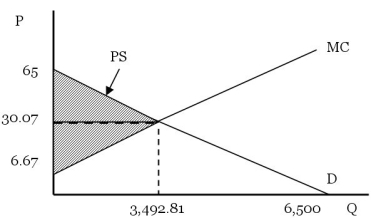Asked by Zacoriya Everfield on Jul 07, 2024

Verified
Internet service in the local market is supplied by Laura's Internet Service. The demand is  Laura's marginal cost function is
Laura's marginal cost function is  If Laura practices first-degree price discrimination, what are consumer surplus and Laura's producer surplus in this market? Does Laura's market power and first-degree price discrimination result in reduced societal welfare?
If Laura practices first-degree price discrimination, what are consumer surplus and Laura's producer surplus in this market? Does Laura's market power and first-degree price discrimination result in reduced societal welfare?
First-Degree Price Discrimination
A pricing strategy where a seller charges each customer the maximum price they are willing to pay.
Producer Surplus
The difference between the amount a producer is paid for a good versus what they would have been willing to accept, reflecting the benefit to producers from participating in the market.
Consumer Surplus
The difference between the total amount consumers are willing to pay for a good or service and the total amount they actually pay.
- Evaluate the financial benefits of various price differentiation methods.

Verified Answer
P = 65 - 0.01Q = MC = 6.67 + 0.0067Q
Therefore Q = 3,492.8
Producer surplus is
PS = (0.5)(65 - 6.67)(3,492.81) = 101,867.80
Since the price of the last unit sold is equal to the marginal cost, Laura's output level is efficient. However, since Laura is first-degree price discriminating, consumer surplus is zero. Social welfare in this market structure is as high as possible given the efficient level of units are produced.


Learning Objectives
- Evaluate the financial benefits of various price differentiation methods.
Related questions
Answer the Question on the Basis of the Following Information ...
If a Monopolist Engages in Price Discrimination,it Will ...
Which of the Following Conditions Is Not Required for Price ...
A Price Discriminating Pure Monopolist Will Attempt to Charge Each ...
For a Firm to Maximize Total Profits Through Price Discrimination,it ...